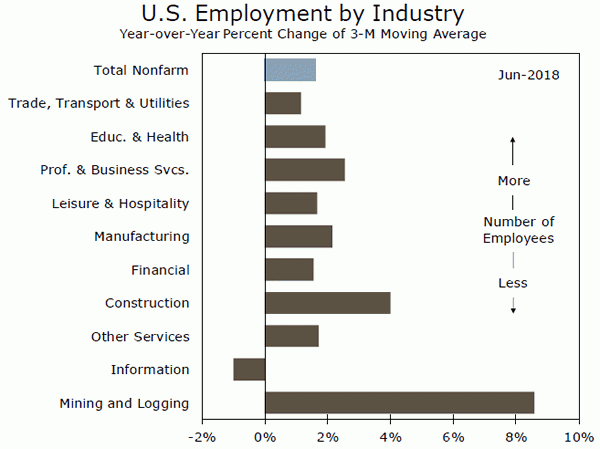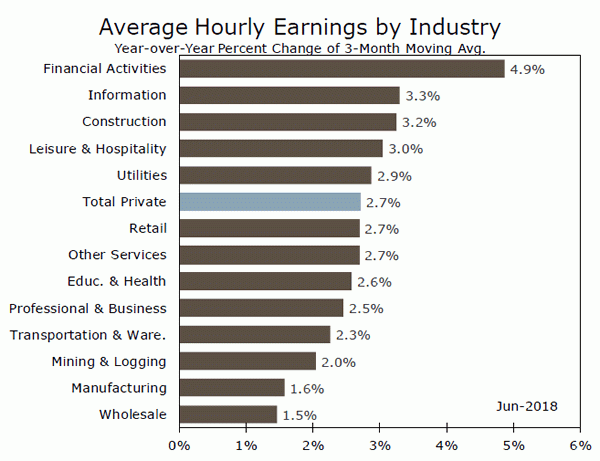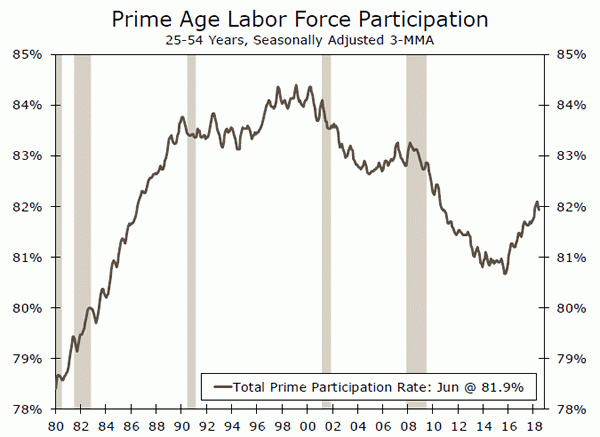June job gains came in at 213,000. Maintaining the momentum of the tight labor market, wages were up 2.7 percent and the unemployment rate rose to 4.0 percent. Fed to raise rates in September.
Job Gains Broad-Based with June Jobs at 213,000
Nonfarm payrolls rose 213,000 in June with the three-month average at a solid 211,000 jobs. The broad-based character of the labor market is evidenced by the rise in the diffusion index to 65.5 for all private industries and at 65.8 for manufacturing firms (compared to 59.2 a year ago). These job gains are consistent with 3.0 percent plus economic growth in the current quarter and a FOMC September rate hike.
Jobs gains appeared broad-based, with most sectors experiencing gains over the month (top graph). Manufacturing jobs continue to show upward momentum—up 36,000 in June and up an average of 28,000 over the past three months. Construction jobs also showed a gain of 13,000 and are up 19,000 on average over the past three months. Over the past three months, aggregate hours worked are up 2.3 percent, annualized, which is very solid and consistent with continued growth in personal income and consumption.
Diversity in Wage Growth – And Real Wage Gains
The theory that workers and employers respond to higher inflation is revealed in the rise in wages, consistent with the recent rise in inflation. However, there is a significant diversity in wage gains (middle graph). Not surprisingly, the service sectors of finance and information appear at the top. What is interesting is that the common perception of low-paid service jobs in leisure & hospitality show evidence of good gains over the past year. Also encouraging are the gains in earnings for construction workers. Finally, real wages are up in many sectors as total CPI inflation is up 2.5 percent through May—note particularly finance, information and construction.
Unemployment Rebounds, but Labor Pool Still Challenging
After falling to 3.8 percent in May, the unemployment rate rebounded to 4.0 percent in June as just over 600,000 workers joined the labor force. That drove the participation rate back up to 62.9 percent and ended a three-month slide in participation rate for prime-age workers (ages 25-54). Despite the influx of workers to the labor force last month, employers are increasingly voicing concerns about finding workers. The number one problem most commonly cited by small businesses is finding qualified labor. While prime-age participation has been improving over the past three years, the rate is only about halfway back to its pre-recession peak, and 2.6 points below its peak in the late 1990s (bottom graph). The pool of available labor—workers officially counted as unemployed plus those not in the labor force but want a job—continues to hover at the lowest rate since 2001.
The dwindling availability of workers should resume downward pressure on the unemployment rate and upward pressure on wages, as some businesses try to attract workers via higher pay. Yet, with fewer workers on the sidelines and slowing population growth, we expect to see payroll growth moderate from the nearly 200,000 monthly average over the past year.















